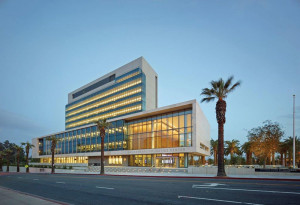Skidmore, Owings & Merrill LLP was an Award Winner for the San Bernardino Justice Center project in the 2014 NCSEA Annual Excellence in Structural Engineering awards program (Category – New Buildings over $100M).
As one of the tallest seismically base isolated buildings in the United States, the Justice Center creates a visible landmark for the city while engaging the public with vibrant open space. The new 400,000 square-foot building improves the efficiency of the courts by consolidating functions that had previously been spread across 12 different buildings throughout the county. Located in one of the most active seismic regions in the U.S., the Justice Center replaces more vulnerable existing facilities. It is designed to meet the Judicial Council of California (JCC) standards to achieve enhanced seismic performance objectives to limit damage and loss of operations under expected moderate to major earthquake events.
The complex consists of two building elements: an 11-story courtroom tower, and a linear, three-story podium. The building’s main entrance is a three-story public lobby. The courthouse tower and podium sit on a one story below-grade level which integrates site sloping grades with building access, courthouse functions and support facilities.
Originally targeting LEED® Silver certification by the U.S. Green Building Council, the courthouse achieved LEED Gold certification at no added cost.
The Justice Center is located in the central business district of the City of San Bernardino in close proximity to known active earthquake faults, including the San Jacinto (M=7.4, 3.9 km), San Andreas (M=7.8, 9.1 km) and the Cucamonga (16.1 km). Site-specific seismic hazards and ground motions, including near fault normal and parallel components, were developed based on Next Generation Attenuation (NGA) relationships – two times greater than ASCE 7-05 code based requirements. The SBJC utilizes seismic base isolation bearings and viscous damping devices as energy dissipation systems to manage the large ground motions and meet the client’s enhanced seismic performance objectives. Seismic assessment and life-cycle analysis (LCA) based on a 25-year return period was conducted during design development. The studies showed an 18.5% return on investment for the seismically isolated superstructure which included estimated mean annual losses from damage to structural, non-structural (drift and acceleration sensitive) and building contents, as well as, loss of use and business interruption impacts.
Superstructure Gravity Framing. The gravity steel-framed structure consists typically of a 3¼-inch lightweight concrete fill over a 3-inch 20-gauge metal deck slab. Composite steel floor framing at mechanical, roof penthouse, Level 1 and below grade levels consists of 4½-inch normal weight concrete fill over a 3-inch 18-gauge metal deck slabs. The typical levels with an open, column-free floor plan and story height of 16 feet accommodates the courtrooms with clear ceiling heights of 12 feet.
Superstructure Lateral Frame. The lateral force resisting system features a cost-effective steel-framed superstructure with two-way special moment-resisting frames on essentially all frame lines in each direction, utilizing both steel wide flange cruciform and built-up box columns with 184 distributed supplementary viscous damping devices (VDD) with extender brace elements supported on an energy dissipating seismic isolation system above the lowest mat foundation level. The VDD brace elements have a 440-kip design force with a +/- 5-inch stroke capacity. Pre-qualified steel moment frame connections include reduced-beam section “RBS” ductile detailing.
Seismic Isolation System. The seismic isolation bearing system, as manufactured by Earthquake Protection Systems, Vallejo, CA, consists of 69 Triple Concave-Friction Pendulum (TC-FP) bearings located above the base mat foundation. The TC-FP isolation bearing system will accommodate up to 42 inches of lateral movement at the seismic isolation plane and perimeter moat walls. The TC-FP bearings transfer gravity and lateral forces to the supporting foundation subgrade via reinforced concrete pedestals and mat foundation slab system. The isolation plane was carefully selected at below the lowest occupied level and at building perimeter conditions to minimize the number of building utilities and service elements required to be detailed to accommodate movements across the seismic isolation plane. Locating the isolation plane above the mat foundation required approximately 55,000 square feet of additional steel framing at the lowest building level.
Courthouse Security. Additionally, the design of the building superstructure incorporates physical security measures to further protect the facility and its inhabitants, consistent with JCC (2006) requirements to provide security and blast resistant mitigation strategies. Redundant perimeter two-way moment frames at the grade level are designed to reduce the potential for progressive collapse.
Conclusions
SBJC is currently the largest project constructed for the JCC and the first to embrace life-cycle analysis considering the long-term structural performance and return on investment in a region of high seismicity. The design of the seismic isolation system and viscous damping devices provide an enhanced seismic performance protecting the structure, non-structural elements, and building contents against future damage, as well as loss of use under the severe demands of expected MCE ground motions.▪

